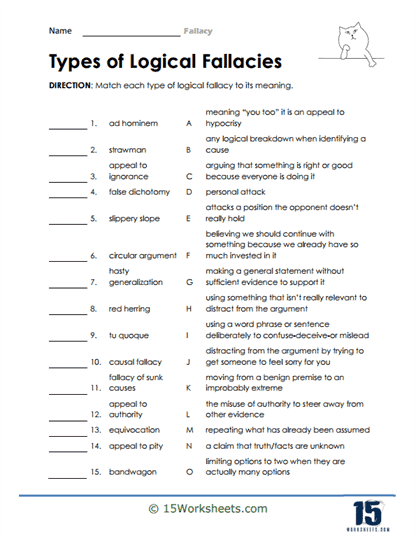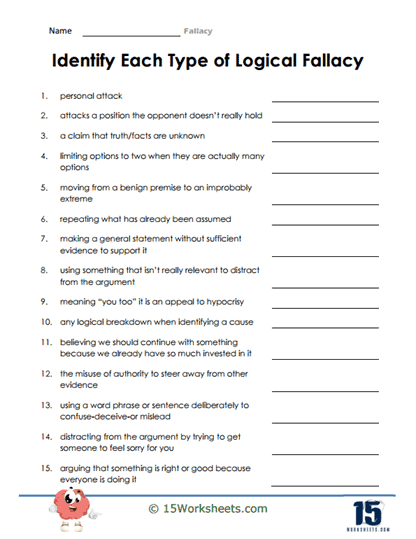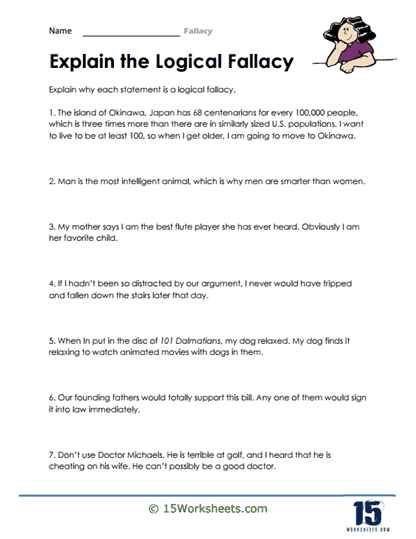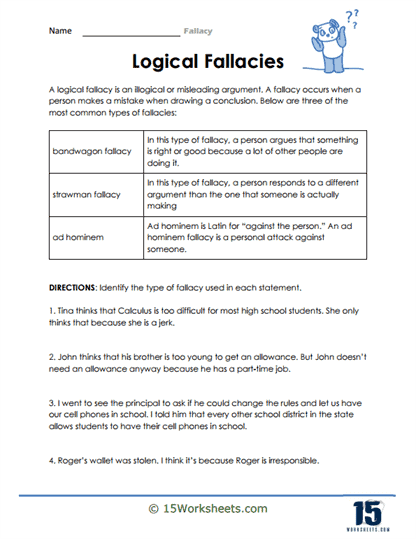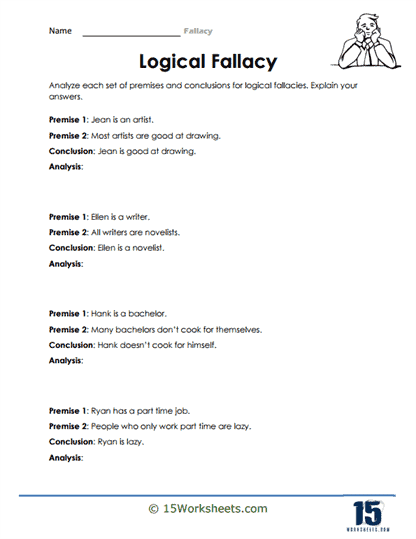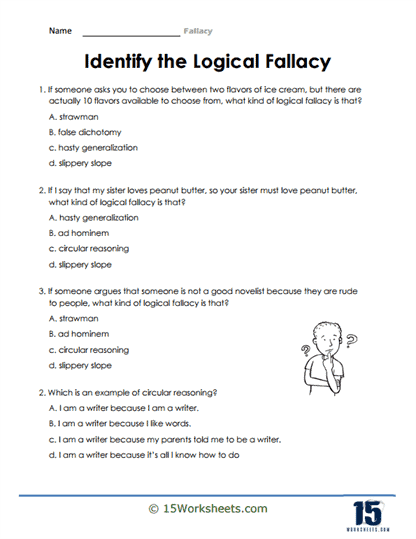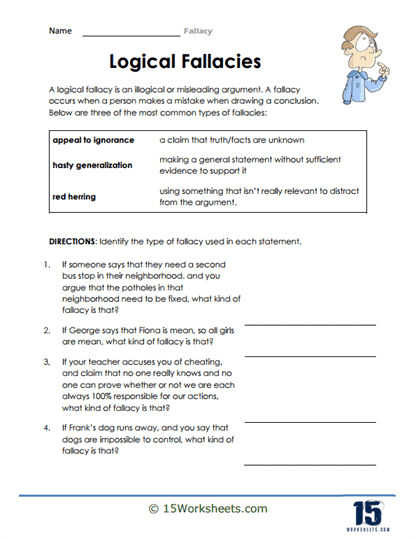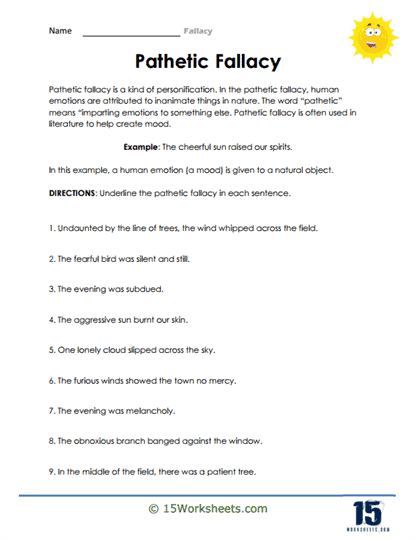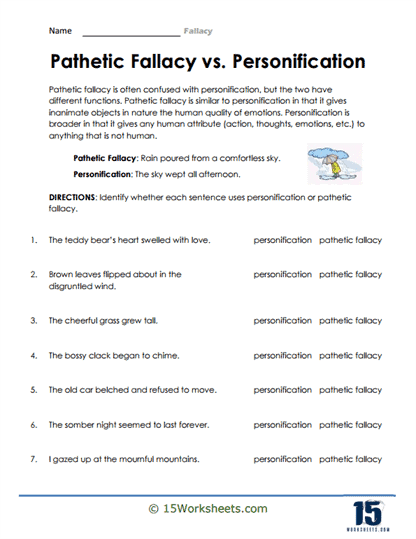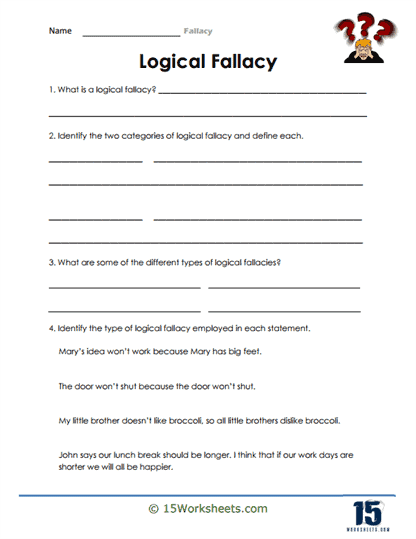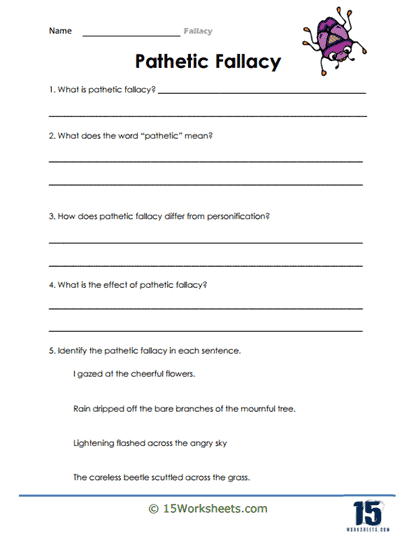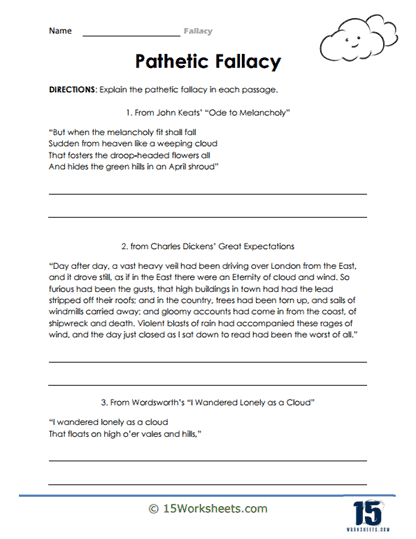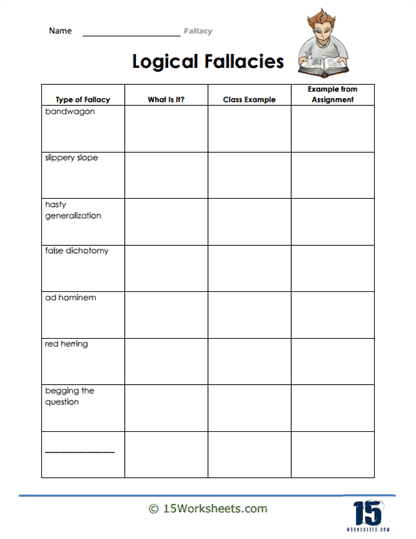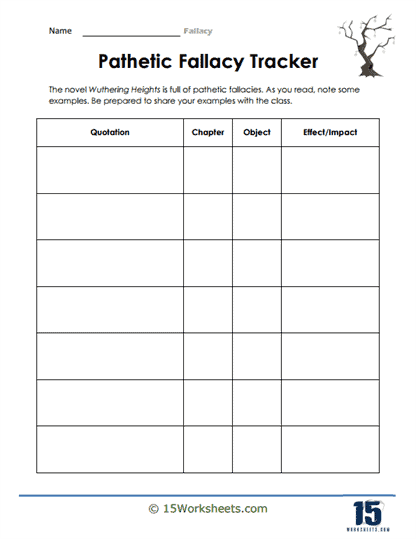Fallacy Worksheets
All About These 15 Worksheets
Fallacies, or errors in reasoning, are pervasive in everyday communication, media, and even academic discourse. Understanding fallacies is crucial for students to become critical thinkers, discerning consumers of information, and effective communicators. This collection of 15 worksheets is designed to introduce students to the world of fallacies, helping them comprehend the importance of identifying and avoiding fallacious arguments, and honing their critical thinking skills.
What Are Fallacy Worksheets?
Fallacy worksheets are used in critical thinking, philosophy, or language arts classes to help students understand and identify common logical fallacies. A “fallacy” is a mistake or flaw in reasoning. They are often used in arguments or debates, sometimes intentionally and sometimes not, but they can make an argument seem weak or illogical if spotted.
Here are the types of exercises you can expect on these worksheets:
Definition Matching – Students will match the names of fallacies with their definitions. For instance, they might have to match “Ad Hominem” with “Attacking the person making the argument, rather than the argument itself.”
Identification – In this exercise, students might be given a series of statements or arguments and asked to identify the fallacy used. For example, for the statement “You can’t trust Jane’s opinion on politics because she’s a teacher,” the student would need to identify this as an Ad Hominem fallacy.
Application – Students will be asked to construct their own examples of specific fallacies. For instance, they could be asked to write a sentence that represents a “Slippery Slope” fallacy.
Multiple-Choice Questions – These could involve identifying the fallacy used in a given sentence or choosing the correct definition of a specific fallacy. Students might be given real-world examples, such as political speeches, advertisements, or articles, and asked to spot and identify any fallacies.
The aim of these worksheets is to help students develop their logical reasoning skills and to prepare them to effectively evaluate arguments and information in their daily lives. By understanding fallacies, students can become more discerning consumers of information and more effective communicators.
What is the Literary Device of Fallacy?
In the context of literature and argumentation, a fallacy refers to a misleading or unsound argument. It’s a flaw or mistake in reasoning, logic, or belief. Fallacies can occur unintentionally due to simple human error, or they can be purposefully employed to manipulate or deceive others.
Interestingly, while fallacies are typically considered detrimental to solid argumentation, in literature, they can be applied strategically. Authors might incorporate fallacies into their work to add depth to their characters, to create conflict, or to promote critical thinking among their readers.
Defining Feature of a Fallacy
The main defining feature of a fallacy is its flawed reasoning. While an argument might seem logically sound on the surface, a fallacy lurks beneath that superficial logic, undercutting the argument’s validity. This deceptive nature is a central feature of fallacies, which often seem convincing until closely scrutinized.
Fallacies can be categorized into two main types – formal and informal. Formal fallacies involve errors in the logical form or structure of an argument, while informal fallacies, which are more common in literature, relate to errors in reasoning and often involve manipulation of content.
Examples of Fallacies in Literature
Ad Hominem Fallacy in “To Kill a Mockingbird” by Harper Lee
In Harper Lee’s classic novel “To Kill a Mockingbird,” the character Tom Robinson is accused of a crime he didn’t commit. However, the townsfolk disregard his innocence based on his race, effectively committing an Ad Hominem fallacy. Rather than considering the facts of the case, they attack Tom’s character and make prejudiced judgments based on his identity. This example prompts readers to consider the fallacy of such reasoning and the broader societal issues of prejudice and injustice.
Straw Man Fallacy in “1984” by George Orwell
In George Orwell’s dystopian novel “1984,” the government of Oceania frequently uses the Straw Man fallacy as a propaganda technique. They misrepresent the views of their enemies to make them easier to attack, such as when they accuse Emanuel Goldstein and his followers of absurd crimes. This allows them to vilify Goldstein and make their own rule seem more palatable in contrast. Through this example, Orwell explores the fallacy’s manipulative potential, particularly when used by those in power.
Slippery Slope Fallacy in “Animal Farm” by George Orwell
Another example from George Orwell’s work, this time in “Animal Farm,” is the Slippery Slope fallacy. This fallacy involves arguing that a particular action will inevitably lead to a specific (usually negative) chain of events, without providing evidence that such a sequence will occur. In the novel, the pigs convince the other animals to accept their increasing power by arguing that if they don’t, the farmer, Mr. Jones, will come back. The animals’ fear of this outcome allows the pigs to seize more control. This fallacy illustrates the dangers of unchecked power and manipulation.
In each of these examples, the authors use fallacies to enrich their stories and promote critical thinking. By recognizing these fallacies, readers are encouraged to question the arguments they encounter in the text and their everyday lives, improving their reasoning skills and promoting a deeper understanding of the story’s themes and messages.
Exploring the world of fallacies through this collection of 15 critical thinking worksheets offers students an opportunity to develop essential skills in critical thinking, media literacy, argumentation, ethical communication, and problem-solving. Fallacies are pervasive in today’s information-rich world, and recognizing them is a key skill for making informed decisions, constructing sound arguments, and avoiding manipulation.
By engaging with these exercises and activities, students not only enhance their academic abilities but also gain valuable tools for success in various aspects of their lives. The benefits of studying fallacies extend far beyond the classroom, empowering students to be discerning thinkers and communicators in an increasingly complex and information-driven society.

